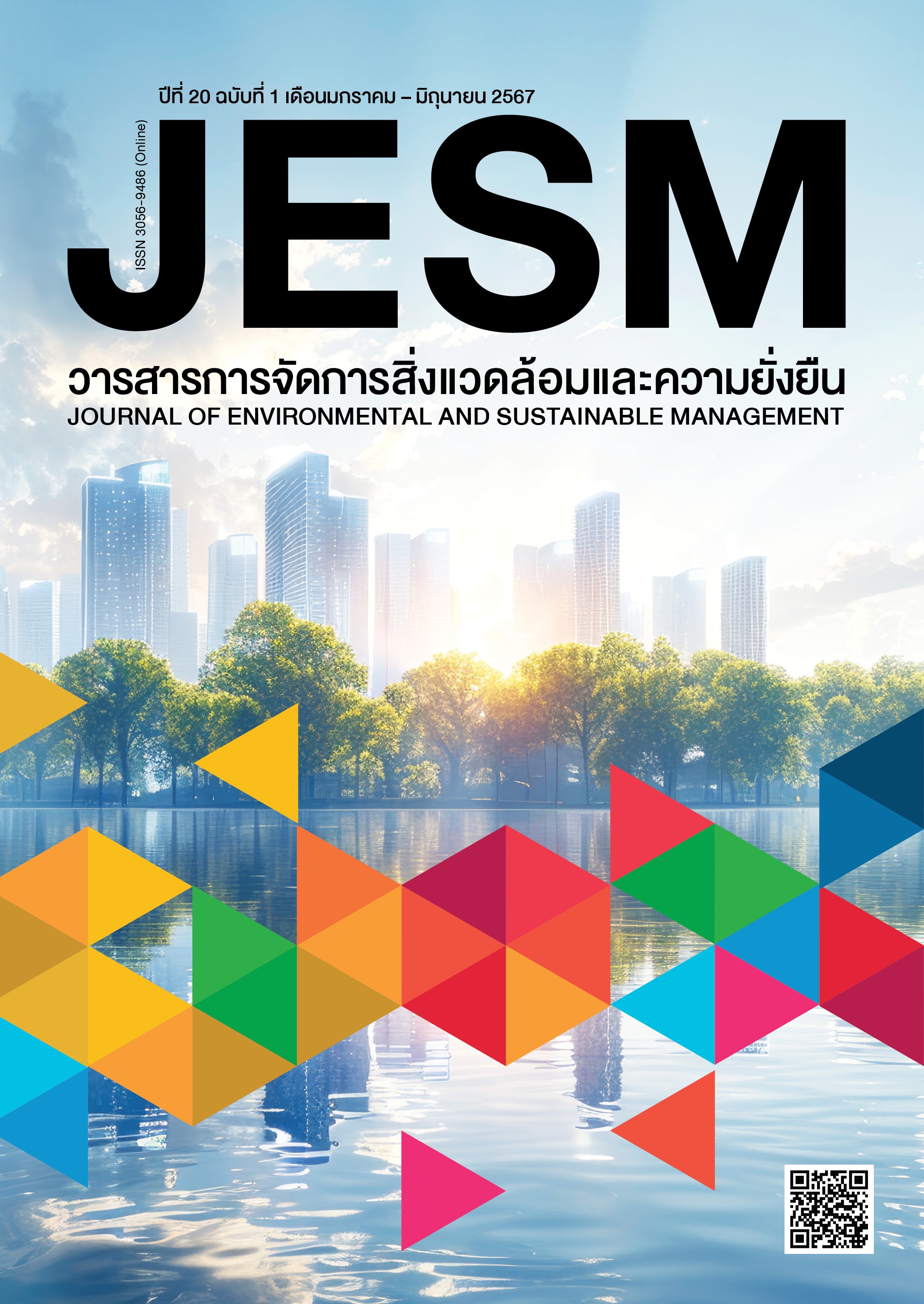การประเมินสถานภาพทรัพยากรน้ำภาคการเกษตรในเขตพื้นที่สูง กรณีศึกษา: ลุ่มน้ำห้วยตอง จังหวัดเชียงใหม่
DOI:
https://doi.org/10.14456/jesm.2024.3คำสำคัญ:
ดัชนีสถานภาพทรัพยากรน้ำ, เกษตรกรรม, ลุ่มน้ำพื้นที่สูง, ลุ่มน้ำห้วยตองบทคัดย่อ
งานวิจัยนี้มีวัตถุประสงค์เพื่อพัฒนาดัชนีและวิธีประเมินสถานภาพทรัพยากรน้ำภาคการเกษตรลุ่มน้ำพื้นที่สูง โดยลุ่มน้ำห้วยตองถูกคัดเลือกให้เป็นลุ่มน้ำตัวแทนเพื่อศึกษาสถานการณ์น้ำเชิงพื้นที่ผ่านการวิจัยแบบมีส่วนร่วมกับชุมชน ผลการประเมินสถานภาพทรัพยากรน้ำในลุ่มน้ำห้วยตองพบว่าอยู่ในภาวะถดถอย ดัชนีบ่งชี้ที่สะท้อนต้นเหตุของปัญหาได้แก่ (1) ความสามารถในการผลิตน้ำต้นทุนและผลผลิตน้ำท่าลดลงในช่วงฤดูแล้ง เนื่องจากพื้นที่ป่ามีขนาดเล็กลงจากการรุกขยายพื้นที่เกษตรกรรม (2) ระบบกักเก็บน้ำต้นทุนไม่เพียงพอสำหรับการเพาะปลูกพืชฤดูแล้ง บ่อเก็บน้ำอยู่ต่ำกว่าพื้นที่เกษตรและชำรุดเสียหายไม่สามารถเก็บน้ำได้ อ่างเก็บน้ำห้วยตองตื้นเขินเก็บน้ำได้เพียงร้อยละ 30 ของความจุอ่างฯ (3) การใช้น้ำเพื่อการเพาะปลูกพืชฤดูแล้งขาดภาวะสมดุลน้ำมากกว่า 1.30 ล้านลูกบาศก์เมตร และ (4) การบริหารจัดการน้ำขาดกลุ่มโครงสร้างการจัดการน้ำแบบมีส่วนร่วมกับชุมชนและหน่วยงานภาครัฐท้องถิ่น สำหรับผลการประเมินข้างต้นสามารถนำไปสู่การวางแผนแก้ไขปัญหาได้อย่างยั่งยืน ทั้งในด้านการอนุรักษ์ ฟื้นฟู ดูแลรักษาพื้นที่ป่าผลิตน้ำ การเพิ่มศักยภาพของระบบกักเก็บและกระจายน้ำ การจัดการพื้นที่เพาะปลูกฤดูแล้ง และการพัฒนากลุ่มท้องถิ่นเพื่อการบริหารจัดการลุ่มน้ำห้วยตอง
เอกสารอ้างอิง
Chankaew, K. (1992). Principles of Watershed Management. Department of Conservation, Faculty of Forestry, Kasetsart University, Bangkok.
Chaves, H.M., & Alipaz, S. (2007). An integrated indicator based on basin hydrology, environment, life, and policy: the watershed sustainability index. Journal of Water Resources Management, 21(2), 883-895.
Department of Conservation Science. (2016). Analysis of the Bang Tra Noi and Huai Sai watershed. Sirindhorn International Environmental Park and adjacent areas, Cha-am District, Phetchaburi Province. Faculty of Forestry, Kasetsart University, Bangkok.
Hewlett,J.D., & Nutter, W.L. (1969). An outline of forest hydrology. Athens: University of Georgia Press.
Highland Research and Development Institute. (2012). Strategy of the Highland Research and Development Institute (Public Organization) Phase 2 (2012-2016). Highland Research and Development Institute, Chiang Mai.
Jomphakdee, W. (2007). River basin management at the local level. Faculty of Engineering Chiang Mai University, Chiang Mai.
Khawsaard, M. (2011). Water management policy guidelines for Thailand. Research Support Office, Bangkok.
Likert, A. (1961). New Patterns of Management. Retrieved June 20, 2022, from http://www.sciepub.com/portal/journals.
Maiklad, P. (2007). Sustainable integrated resource management. Kasetsart University, Bangkok.
National Statistical Office. (2020). Indicators for sustainable water resource management services. Office of the Secretary of the Department, Bangkok.
Northern Irrigation Hydrology Center. (2022). Status of rainfall and runoff. Retrieved June 20, 2022, from: https://hydro-1.net.
Prakongsri, P. (2008). Guidelines for water resource management and master plans for water resource management in various river basins. Royal Irrigation Department, Bangkok.
Preechapanya, P. (2007). Participatory Watershed Management. Thanaban Publishing, Chiang Mai.
Saaty, T.L. (2008). Decision making with the analytic hierarchy process. Journal of Services Sciences, 10(3), 83-98.
Tangtham, N., & Yuwananont, S. (1996). Effects of land use change on the quantity and flow characteristics of runoff in the Pa Sak River Basin. Forestry Journal, 15(3), 98-110.
Wallace, J.S., Acreman, M.C., & Sullivan, C.A. (2003). The sharing of water between society and ecosystems: from conflict to catchment-based co-management. Journal of Biological sciences, 358(1), 1011-1025.



